Behavior Profiles at 2 Years for Children Born Extremely Preterm with Bronchopulmonary Dysplasia
- PMID: 32008764
- PMCID: PMC7096270
- DOI: 10.1016/j.jpeds.2019.12.028
Behavior Profiles at 2 Years for Children Born Extremely Preterm with Bronchopulmonary Dysplasia
Abstract
Objective: To characterize behavior of 2-year-old children based on the severity of bronchopulmonary dysplasia (BPD).
Study design: We studied children born at 22-26 weeks of gestation and assessed at 22-26 months of corrected age with the Child Behavior Checklist (CBCL). BPD was classified by the level of respiratory support at 36 weeks of postmenstrual age. CBCL syndrome scales were the primary outcomes. The relationship between BPD grade and behavior was evaluated, adjusting for perinatal confounders. Mediation analysis was performed to evaluate whether cognitive, language, or motor skills mediated the effect of BPD grade on behavior.
Results: Of 2310 children, 1208 (52%) had no BPD, 806 (35%) had grade 1 BPD, 177 (8%) had grade 2 BPD, and 119 (5%) had grade 3 BPD. Withdrawn behavior (P < .001) and pervasive developmental problems (P < .001) increased with worsening BPD grade. Sleep problems (P = .008) and aggressive behavior (P = .023) decreased with worsening BPD grade. Children with grade 3 BPD scored 2 points worse for withdrawn behavior and pervasive developmental problems and 2 points better for externalizing problems, sleep problems, and aggressive behavior than children without BPD. Cognitive, language, and motor skills mediated the effect of BPD grade on the attention problems, emotionally reactive, somatic complaints, and withdrawn CBCL syndrome scales (P values < .05).
Conclusions: BPD grade was associated with increased risk of withdrawn behavior and pervasive developmental problems but with decreased risk of sleep problems and aggressive behavior. The relationship between BPD and behavior is complex. Cognitive, language, and motor skills mediate the effects of BPD grade on some problem behaviors.
Keywords: BPD; bayley scales of infant and toddler development; child behavior checklist; cognitive; infants born premature; language; motor.
Copyright © 2019 Elsevier Inc. All rights reserved.
Figures




Comment in
-
Does the 2-year behavioural profile of children born extremely preterm change with bronchopulmonary dysplasia severity?Acta Paediatr. 2021 May;110(5):1697-1698. doi: 10.1111/apa.15735. Epub 2021 Jan 22. Acta Paediatr. 2021. PMID: 33484029 No abstract available.
References
-
- Aarnoudse-Moens CS, Weisglas-Kuperus N, van Goudoever JB, Oosterlaan J. Meta-analysis of neurobehavioral outcomes in very preterm and/or very low birth weight children. Pediatrics 2009;124:717–28. - PubMed
-
- Samuelsson M, Holsti A, Adamsson M, Serenius F, Hägglöf B, Farooqi A. Behavioral patterns in adolescents born at 23 to 25 weeks of gestation. Pediatrics 2017;140:e20170199. - PubMed
-
- Johnson S, Marlow N. Preterm birth and childhood psychiatric disorders. Pediatr Res 2011;69:11R–8R. - PubMed
-
- Burnett AC, Youssef G, Anderson PJ, Duff J, Doyle LW, Cheong JLY, et al. Exploring the “preterm behavioral phenotype” in children born extremely preterm. J Dev Behav Pediatr 2019;40:200–7. - PubMed
Publication types
MeSH terms
Grants and funding
- L40 HD099827/HD/NICHD NIH HHS/United States
- F32 HD098782/HD/NICHD NIH HHS/United States
- UG1 HD068244/HD/NICHD NIH HHS/United States
- UG1 HD034216/HD/NICHD NIH HHS/United States
- UG1 HD027904/HD/NICHD NIH HHS/United States
- KL2 TR003168/TR/NCATS NIH HHS/United States
- UG1 HD027880/HD/NICHD NIH HHS/United States
- UG1 HD053109/HD/NICHD NIH HHS/United States
- UG1 HD087229/HD/NICHD NIH HHS/United States
- UL1 TR003167/TR/NCATS NIH HHS/United States
- UG1 HD068278/HD/NICHD NIH HHS/United States
- U24 HD095254/HD/NICHD NIH HHS/United States
LinkOut - more resources
Full Text Sources
Medical

